Ecology - Mod 10 (Ch 14): Competition
1/22
Earn XP
Name | Mastery | Learn | Test | Matching | Spaced |
|---|
No study sessions yet.
23 Terms
community
populations of different species living and potentially interacting in a certain area at a given time
different species interactions (5 types) and how they impact the survival (Sx) and fecundity (Fx) of each individual involved
competition (-/-)
mutualism (+/+)
predation (+/-)
herbivory(+/-)
parasites and pathogens (+/-)
competition
interaction between two or more individuals both requiring the same limited resource that, when used/defended by one individual, reduces the survival or reproduction of the other
two types: intraspecific and interspecific
usually reduces Sx and Fx of both individuals (but not always)
subdivisions: interference competition and exploitative competition
limited resource
something that is consumed and thus reduced
resource
anything in the environment that is used or consumed
Liebig’s law of the minimum
most limited resource = limiting resource
limiting resource ultimately determines population growth rate
example of competition reducing Sx and Fx of two individuals
Brown & Davidson
2 species, ant and rodent, both ate same limiting resource (same size seeds)
population sizes of both species were affected when in the presence of the other; changed when the other was removed
seed densities were reduced to the same level whether together or alone, so not eating as much as they could when together
exploitative competition
direct interactions
individuals fight for access to limiting resources
e.g. direct fight between hyena and vulture over a carcass
can occur in both interspecific and intraspecific competition
interference competition
indirect interactions
affect others from accessing resources by consuming the resources first
e.g. roots crowding out other roots; faster-growing roots get more water
e.g. allelopathy
plants growing for sunlight; plants below get little sunlight
ecological niche
range of abiotic and biotic conditions within which individuals of a species can survive, grow, and reproduce
e.g. what they eat (type, size, where found), where they live (location, climate), when they are active (day, night)
can be fundamental or realized niche
fundamental niche
ALL area in which an individual/species can live
all areas where a species has the potential to use all of certain resources
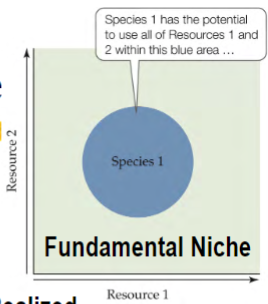
realized niche
the limited part of area in the fundamental niche where an individual/species can ACTUALLY use because of interactions/competition with other species
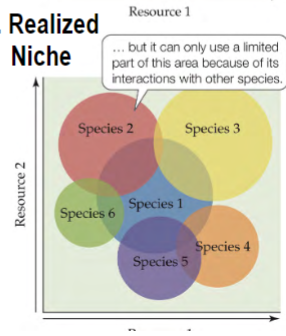
example of fundamental vs realized niche
Chthalamus and Balanus barnacles in rocky intertidal zones of Scotland
both live on rocky intertidal zones
Cthalamus is very desiccation tolerant, can occur in regions exposed from low tide until high tide
Balanus is less tolerant to desiccation
competition —> Cthalamus is limited to areas where Balanus cannot occur
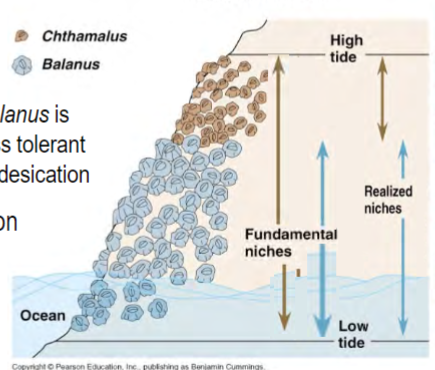
competitive exclusion principle
two species cannot coexist indefinitely on the same limiting resource (i.e. with substantial niche overlap)
when niches overlap substantially, two outcomes: competitive exclusion of 1 species, or coexistence via resource (niche) partitioning
A.G. Tansley tested it in 1917 with 2 species of Galium plant
Gause tested in lab in 1934
A.G. Tansley’s 1917 test of the competitive exclusion principle
observed 2 closely related species of Galium, generally not occurring together (G. saxatile and G. sylvestre)
each spp. grown alone can grow on either soil, but survival and growth were higher on their preferred soil (G. saxatile on soil A, G. sylvestre on soil A)
when grown together, spp. on nonpreferred soil has reduced survival and growth (goes locally extinct)
G. saxatile dominated growth and G. sylvestre went locally extinct on soil A
G. sylvestre dominated growth and G. saxatile went locally extinct on soil B
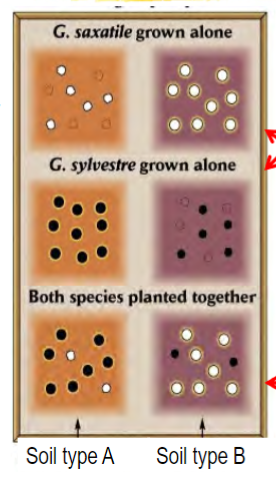
competitive exclusion
when the inferior competitor goes locally extinct when niches overlap substantially
e.g. Galium in Tansley’s experiment
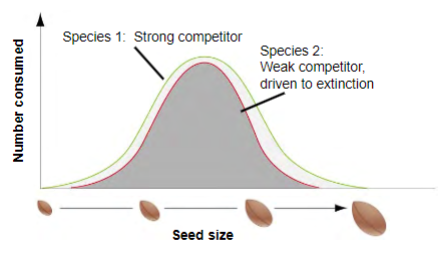
coexistence via resource (niche) partitioning
similar species can coexist if they share (partition) the resources such that their niches no longer completely overlap
i.e. natural selection drives competing species into different patterns of resource use and thus different niches
allows each spp to use a subset of the resource
partitioning can happen by specialization on a:
physical attribute (particular size, color, etc.), spatial attribute (choose resources occurring in a specific location), temporal attribute (use resources only during a specific time)
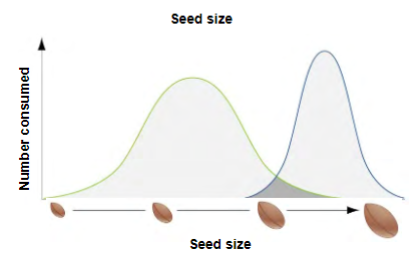
changes from adaptive evolution that allow specialization and niche partitioning
morphology (e.g. shorebird beak shapes changing to specialize on insects at different depths and different sized insects; anoles specializing on insects in different parts of a tree and different sized insects)
physiology (e.g. Fowler’s toad and spring peeper breed at slightly offset times. Tadpoles hatch in different months, so don’t compete for food)
behavior (same for physiology example)
behavioral differentiation due to adaptive evolution vs learned response
morphological/physiological differentiation occurs via adaptive evolution, not easily changed
behavioral differentiation may be due to adaptive evolution OR a learned response
e.g. common spiny mouse (nocturnal) vs golden spiny mouse (diurnal) both coexist in rocks near the Dead Sea. When nocturnal spp. was removed, after a few months the diurnal spp. could be found at night. —> learned response resulted in differentiation, which led to partitioning of niches
character displacement
type of niche partitioning that occurs only where two species occur together
when 2 spp differ only when together vs when alone
e.g. Darwin’s finches
(see example 14.17 in book: chipmunk spp. in mountain ranges)
Lotka-Volterra competition model of competition
developed in 1920s
2 models for population growth rates of 2 competitors
modification of logistic equation
considers both intraspecific and interspecific competition in reducing a population’s growth rate, not just intraspecific
how close N is to K still determines growth rate, but differences from logistic growth:
adding individuals of another spp. may also bring a population closer to K and affect its growth rate
adding an individual from your own spp. affects your population growth rate differently than adding an individual of a different spp.

what everything in the Lotka-Volterra competition model represents
1 = spp. 1
2 = spp. 2
r = intrinsic rate of increase (i.e. how fast the population can grow)
N = population size
K = carrying capacity
t = time
α = competitive effect of spp. 2 on 1 (degree to which individuals of spp. 1 use the resources of individuals of spp. 2)
beta = competitive effect of spp. 1 on 2 (degree to which individuals of spp. 2 use the resources of individuals of spp. 1)
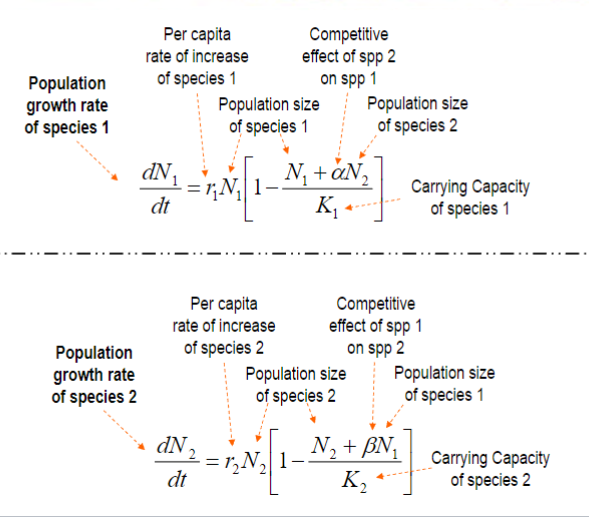
adding an individual of your own spp. vs another spp. in the Lotka-Volterra competition model
if α=1: adding an individual of spp. 1 or 2 has the same effect on population growth rate
if α<1: adding an individual of spp. 2 has less effect than adding an individual of spp. 1 (assuming spp. 1 is your own spp. and spp. 2 is the competing spp.)
if α>1: adding an individual of spp. 2 has a greater effect than adding an individual of spp. 1
if α=0: no competition; equation reduces to the logistic equation
same if beta replaces α